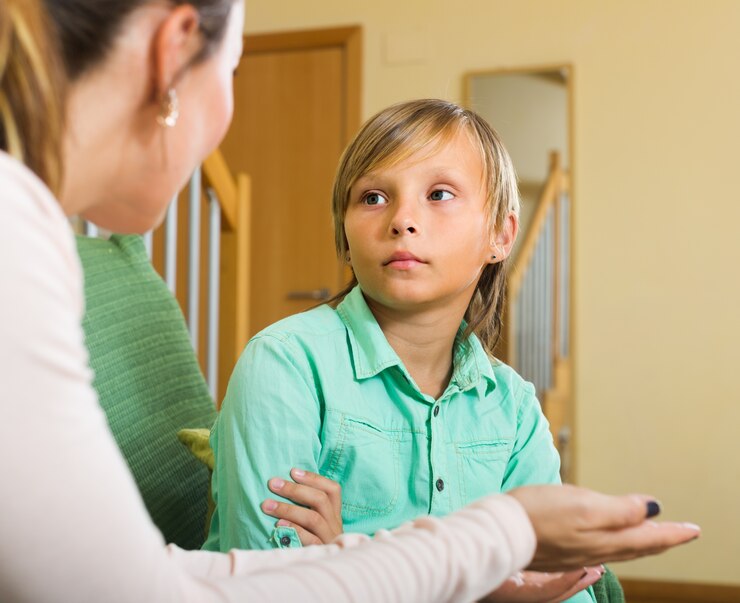
Effective Ways to Use Constructive Discipline for Children

Constructive discipline is a positive approach to guiding children’s behavior by focusing on teaching and reinforcing desired behaviors rather than punishing unwanted ones. This method emphasizes respect, understanding, and clear communication between parents and children. Constructive discipline is important because it helps children develop self-discipline, responsibility, and social skills, while fostering a nurturing and supportive environment.
The impact of constructive discipline on children is profound. It promotes a sense of security and trust, enhances self-esteem, and encourages cooperation. By understanding the principles of constructive discipline and implementing effective strategies, parents can guide their children towards positive behavior and healthy development.

What is Constructive Discipline?
Constructive discipline is an approach that focuses on teaching children appropriate behavior through positive reinforcement, clear expectations, and consistent guidance. Unlike punitive discipline, which relies on fear and punishment, constructive discipline aims to build a child’s understanding of right and wrong through empathy and mutual respect. It involves setting clear rules, providing consistent consequences, and offering praise and encouragement for good behavior.
Why is Constructive Discipline Important?
Constructive discipline is crucial because it helps children develop important life skills such as self-control, empathy, and problem-solving. It creates a positive learning environment where children feel valued and understood. By using constructive discipline, parents can build a strong, healthy relationship with their children, based on trust and mutual respect. This approach also reduces behavioral issues and promotes emotional well-being, leading to a more harmonious family dynamic.
Impact of Constructive Discipline on Children
The impact of constructive discipline on children is significant and multifaceted. Children who are disciplined constructively are more likely to exhibit positive behavior, have higher self-esteem, and perform better academically. They learn to understand the consequences of their actions and develop the ability to make better choices. Constructive discipline also fosters a sense of responsibility and independence, as children are encouraged to take ownership of their behavior and learn from their mistakes.
Ways to Use Constructive Discipline
Set Clear Expectations and Rules
One of the fundamental aspects of constructive discipline is setting clear expectations and rules. Children need to know what is expected of them and the boundaries within which they should operate. Clear rules provide a sense of structure and security, helping children understand the difference between acceptable and unacceptable behavior. When setting rules, it’s important to be specific, consistent, and age-appropriate.
Use Positive Reinforcement
Positive reinforcement involves rewarding children for displaying desired behaviors. This can be in the form of verbal praise, physical affection, or tangible rewards such as stickers or extra playtime. Positive reinforcement encourages children to repeat positive behaviors and helps them understand the benefits of following rules and meeting expectations. It also boosts their self-esteem and motivation.
Offer Choices and Consequences
Giving children choices within set boundaries empowers them and teaches them responsibility. When children have a say in their actions, they are more likely to cooperate and follow through with positive behavior. Additionally, it’s important to communicate the consequences of their choices, both positive and negative. For example, “If you finish your homework, you can watch your favorite show. If not, you’ll need to spend that time catching up on schoolwork.”
Practice Active Listening
Active listening is a key component of constructive discipline. It involves giving children your full attention, acknowledging their feelings, and responding thoughtfully. By practicing active listening, parents can better understand their children’s perspectives, build trust, and address underlying issues that may be contributing to behavioral problems. This approach helps children feel heard and valued, which can reduce frustration and improve behavior.

Model Appropriate Behavior
Children learn by observing the behavior of adults, particularly their parents. Modeling appropriate behavior is a powerful way to teach children how to act in various situations. By demonstrating positive behaviors such as patience, respect, and empathy, parents can set a strong example for their children to follow. It’s important to be consistent in your actions and words, as children are keen observers and imitators.
Implement Consistent Consequences
Consistency is crucial in constructive discipline. Children need to know that rules and consequences are predictable and will be enforced every time. Inconsistent discipline can confuse children and undermine the effectiveness of the approach. Consistent consequences help children understand the relationship between their actions and the outcomes, reinforcing the importance of following rules and meeting expectations.
Encourage Problem-Solving Skills
Teaching children problem-solving skills is an essential part of constructive discipline. When children encounter conflicts or challenges, parents can guide them through the process of finding solutions. This involves identifying the problem, brainstorming possible solutions, evaluating the options, and choosing the best course of action. Encouraging problem-solving helps children develop critical thinking skills and fosters independence.
Use Time-Outs Effectively
Time-outs can be a useful tool in constructive discipline when used appropriately. Rather than using time-outs as a punishment, they should be viewed as an opportunity for the child to calm down and reflect on their behavior. The key is to ensure that time-outs are not overly long or isolating. A quiet, designated space where the child can relax and regain composure is ideal. After the time-out, it’s important to discuss the behavior and reinforce positive alternatives.
Establish a Routine
A consistent daily routine provides children with a sense of stability and predictability, which can reduce anxiety and behavioral issues. Establishing a routine for activities such as meals, homework, and bedtime helps children understand what is expected of them and when. It also promotes time management skills and a sense of responsibility.
Communicate Respectfully
Respectful communication is a cornerstone of constructive discipline. This involves speaking to children in a calm and respectful manner, even when addressing behavioral issues. Avoid yelling, sarcasm, or belittling language, as these can damage the parent-child relationship and lead to resentment. Instead, use “I” statements to express your feelings and concerns, and encourage open dialogue.
Implement Natural and Logical Consequences
Natural and logical consequences are effective tools in constructive discipline. Natural consequences occur as a direct result of the child’s actions without parental intervention. For example, if a child refuses to wear a coat, they may feel cold outside. Logical consequences are imposed by the parent and are directly related to the behavior. For example, if a child draws on the wall, they are responsible for cleaning it up. These types of consequences help children understand the impact of their actions and learn from their mistakes.
Reinforce Positive Behavior with Attention
Children often seek attention from their parents, and this can be leveraged to reinforce positive behavior. Providing attention for positive behaviors, such as cooperation or kindness, encourages children to repeat these actions. This can be as simple as giving a smile, a hug, or a few words of praise. By focusing on and acknowledging positive behavior, parents can help shape their children’s actions in a constructive manner.
Develop Empathy and Understanding
Empathy is an important skill that helps children understand and relate to the feelings of others. Parents can foster empathy by discussing emotions and encouraging children to consider how their actions affect others. This can be done through role-playing, reading stories about different perspectives, or discussing real-life situations. Developing empathy helps children build stronger relationships and reduces the likelihood of aggressive or unkind behavior.

Establish Clear and Fair Consequences
Consequences should be clear, fair, and related to the behavior. When children understand the consequences of their actions, they are more likely to modify their behavior to avoid negative outcomes. It’s important to explain the consequences in advance and follow through consistently. Fair consequences are proportional to the behavior and help children learn about accountability and responsibility.
Use Family Meetings for Discussion
Family meetings provide a structured opportunity for discussing behavior, setting goals, and resolving conflicts. These meetings should be held regularly and include all family members. During the meetings, parents can review rules, address any issues, and involve children in decision-making. This collaborative approach helps children feel involved and valued, and promotes a sense of unity within the family.
Focus on Solutions, Not Problems
When addressing behavioral issues, it’s important to focus on finding solutions rather than dwelling on the problem. This involves identifying the underlying cause of the behavior and working together to develop strategies for improvement. By focusing on solutions, parents can help children feel empowered and motivated to change their behavior.
Encourage Responsibility
Encouraging children to take responsibility for their actions is a key aspect of constructive discipline. This involves holding children accountable for their behavior and helping them understand the consequences of their actions. Parents can encourage responsibility by assigning age-appropriate chores, setting expectations for schoolwork, and involving children in decision-making processes.
Use Praise and Encouragement
Praise and encouragement are powerful tools in constructive discipline. They reinforce positive behavior and boost children’s self-esteem. When offering praise, it’s important to be specific and genuine. Instead of generic statements like “Good job,” provide specific feedback such as “I really appreciate how you helped clean up the toys without being asked.”
Set Realistic Expectations
Setting realistic expectations is crucial for effective discipline. Parents should consider their child’s age, developmental stage, and individual capabilities when establishing rules and expectations. Unrealistic expectations can lead to frustration and disappointment for both parents and children. By setting achievable goals, parents can help children experience success and build confidence.
Maintain a Positive Attitude
A positive attitude is essential in constructive discipline. Parents should approach discipline with patience, understanding, and optimism. A positive attitude helps create a supportive environment where children feel encouraged to improve their behavior. It also sets a positive example for children to follow.
Use Non-Verbal Communication
Non-verbal communication, such as body language and facial expressions, plays a significant role in discipline. Parents can use non-verbal cues to reinforce rules and expectations. For example, a stern look or a raised eyebrow can signal disapproval, while a smile or a nod can indicate approval. Non-verbal communication should be consistent with verbal messages to avoid confusion.
Develop a Support System
Having a support system is important for both parents and children. This can include extended family, friends, teachers, and other trusted adults who can provide guidance and support. A strong support system helps reinforce positive behavior and provides additional resources for addressing behavioral issues.
Promote Self-Discipline
Self-discipline is the ability to regulate one’s behavior and make positive choices independently. Parents can promote self-discipline by teaching children to set goals, manage their time, and take responsibility for their actions. Encouraging self-discipline helps children develop the skills they need to succeed in various aspects of life.
Address Behavioral Issues Early
It’s important to address behavioral issues as soon as they arise. Ignoring or delaying intervention can lead to more serious problems. Parents should address issues promptly and consistently, using constructive discipline techniques. Early intervention helps prevent minor issues from escalating and promotes a positive behavior pattern.
Foster a Positive Relationship
A strong, positive relationship between parents and children is the foundation of effective discipline. Building a positive relationship involves spending quality time together, showing affection, and providing support and encouragement. A positive relationship fosters trust and cooperation, making it easier to address behavioral issues and guide children towards positive behavior.
Utilize Educational Resources
There are numerous educational resources available to help parents with constructive discipline. Books, articles, workshops, and parenting classes can provide valuable information and strategies. Parents should take advantage of these resources to enhance their knowledge and skills in constructive discipline.

Constructive discipline is a powerful approach to guiding children’s behavior in a positive and respectful manner. By setting clear expectations, using positive reinforcement, and fostering open communication, parents can help their children develop important life skills, build self-esteem, and form healthy relationships. Implementing these strategies consistently can lead to a more harmonious and supportive family environment, promoting the overall well-being and development of children.
Read Also:
Transforming Education and Parenting: A Positive Approach for the Modern Era